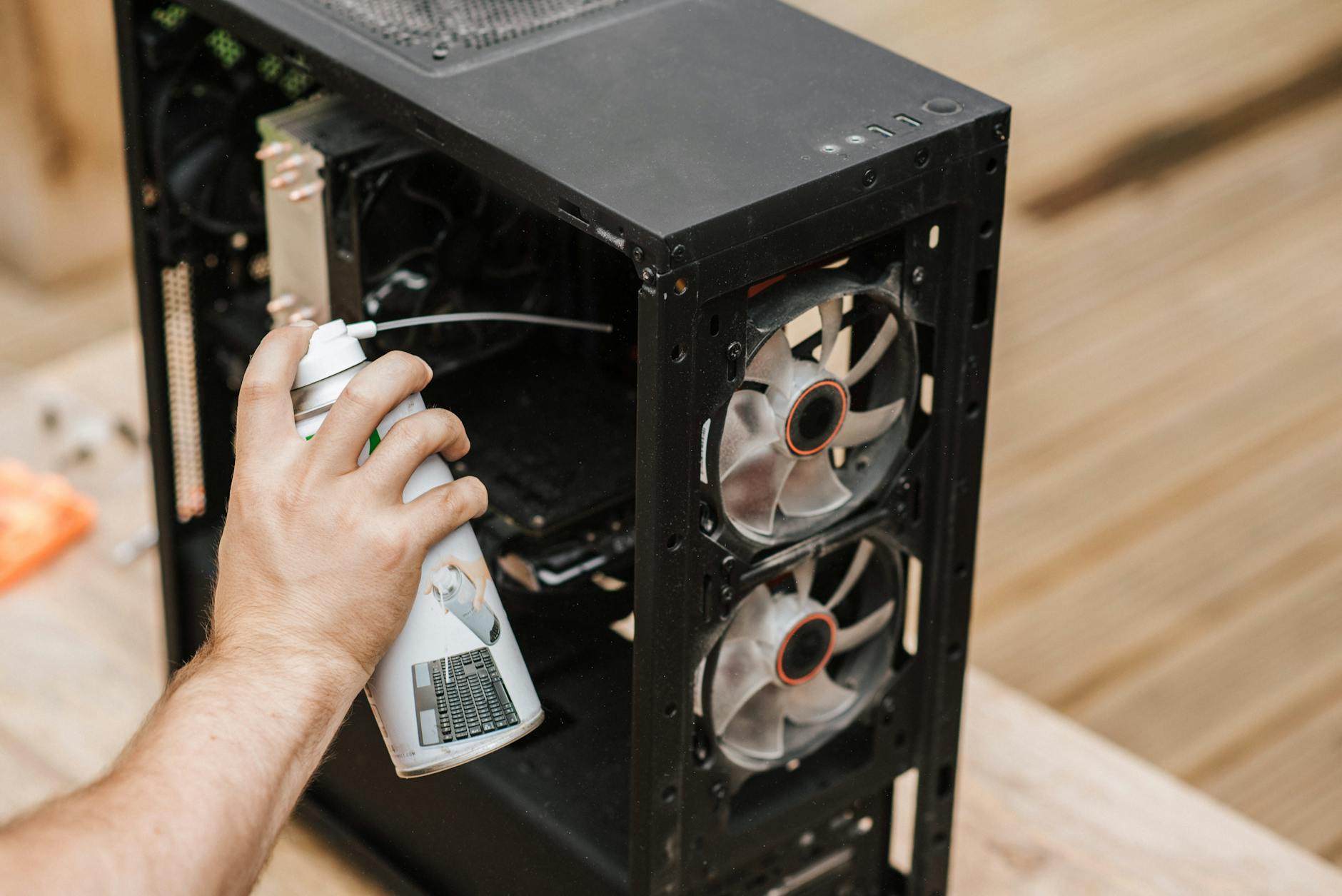Your cart is currently empty!
Your computer case isn’t just a fancy box to hold all your components; it’s a carefully engineered environment designed to keep your valuable hardware cool. Whether you’re a gamer pushing your system to its limits, a creative professional rendering a complex project, or just a casual user who wants a quiet, reliable machine, understanding airflow and thermal management is key. Neglecting proper cooling can lead to performance throttling, system instability, and even permanent damage to components.
At ASCS, we often see computers come in with overheating issues. Many times, the problem isn’t a faulty part but simply a lack of proper cooling setup. The good news? Optimizing your PC’s airflow is often a simple, affordable, and incredibly effective way to boost performance and extend the lifespan of your machine.
Let’s dive into the core principles of PC cooling and how you can ensure your computer stays cool under pressure.
✅ Step 1: Understanding the Basics of Airflow
The goal of PC cooling is to get cool air in, move it over heat-generating components, and get the hot air out. This is a continuous cycle, and disrupting it can lead to heat buildup.
🔄 The “Hot Air Rises” Principle
Hot air is less dense than cold air, so it naturally rises. A well-designed case takes advantage of this principle. The most common and effective airflow setup is a positive pressure system.
🔌 Positive vs. Negative Pressure
- Positive Pressure: More air is being pushed into the case than is being pulled out. This creates a slightly pressurized environment, forcing air out through all available vents. This is ideal because it helps prevent dust from entering through unfiltered gaps.
- Negative Pressure: More air is being pulled out of the case than is being pushed in. This creates a slight vacuum, sucking air in through any opening, including unfiltered cracks. This can lead to a build-up of dust over time.
- Balanced Pressure: An equal amount of air is pushed in and pulled out. This is a good compromise, but positive pressure is generally preferred for dust control.
🛠️ Step 2: Optimizing Your Fan Setup
Once you understand the basic principles, you can start optimizing your case fans. Most modern PC cases have designated spots for intake and exhaust fans.
📌 Scenario 1: The Ideal Airflow Path
The most effective airflow path follows a straight line.
- Intake Fans: Place intake fans at the front and bottom of the case. These fans should be pulling in cool, fresh air from outside.
- Exhaust Fans: Place exhaust fans at the top and rear of the case. These fans should be pushing hot air out of the case.
Try This:
- Front Fans: 2x 120mm or 140mm fans as intake.
- Rear Fan: 1x 120mm or 140mm fan as exhaust.
- Top Fans: 1-2x 120mm or 140mm fans as exhaust.
- Tip: If you have a large graphics card, a fan at the bottom of the case blowing air directly up onto the GPU can make a significant difference.
⚠️ Scenario 2: Dealing with Dust
Dust is the enemy of airflow. It clogs up fans, coats heatsinks, and acts as an insulator, trapping heat.
Try This:
- Use Filters: Most quality cases come with removable dust filters on the intake fan areas. Make sure these filters are in place and cleaned regularly.
- Clean Regularly: Every few months, open your PC case and use a can of compressed air or an electric air duster to blow out accumulated dust. Be sure to hold the fan blades in place while you do this to prevent them from spinning too fast.
🔄 Scenario 3: Cable Management
Messy cables inside your case can block airflow, creating “dead spots” where hot air gets trapped.
Try This:
- Route Cables Behind the Motherboard: Most modern cases have space behind the motherboard tray for routing cables.
- Use Zip Ties or Velcro Straps: Tidy up loose cables and bundle them together to create a clear path for air to flow from the front to the back of the case.
- Modular Power Supply: If you’re building a new PC, consider a modular power supply, which allows you to only connect the cables you need, reducing clutter.
🧰 Step 3: Checking Component-Specific Cooling
Airflow is a system-wide effort, but some components generate more heat than others and need special attention.
📌 The CPU Cooler
Your CPU is the brain of your computer and generates a lot of heat. The cooler (whether it’s the stock one, a large air cooler, or a liquid cooler) is essential for its thermal health.
Try This:
- Check Thermal Paste: The thermal paste between your CPU and its cooler needs to be applied correctly. If you’ve recently installed a new cooler, ensure you’ve used a fresh application. If you have an older system, replacing the thermal paste every few years can improve cooling.
- Fan Orientation: Ensure the fan on your air cooler is blowing in the correct direction—usually from the front of the case toward the back exhaust fan.
⚠️ The GPU (Graphics Card)
Your graphics card is often the hottest component in your system, especially during gaming.
Try This:
- Ensure it has room to breathe: Make sure there’s at least a small gap between the bottom of your GPU and any other components or the case floor.
- Consider a Vertical Mount: Some cases and mounting kits allow you to vertically mount your GPU, which can sometimes improve its access to cool air.
🧰 Still Overheating? Bring It to the Pros
If you’ve followed these steps and your computer is still running hot, don’t stress—AS Computer Solutions is here to help. There could be an underlying issue that’s not immediately obvious.
We can:
- Perform advanced diagnostics to identify faulty fans or sensors.
- Professionally clean and re-apply thermal paste.
- Recommend and install new cooling solutions tailored to your components and budget.
- Check for underlying issues like malware or system corruption that could be causing excessive CPU/GPU usage.
🏡 Local. Reliable. Ready to Help.
Serving Onoway and surrounding communities, AS Computer Solutions is your go-to for friendly, affordable tech support. We’ll get your computer running cool, quiet, and fast again.
Don’t let a hot PC slow you down. Try the steps above first, and if you’re still stuck, give us a shout. We’ll get your computer—and your productivity—back on track.
Call or visit us today: 📞 (780) 967 0215 🌐 www.site.ascsonoway.com📍 Onoway, Alberta 📧 [email protected]


Leave a Reply